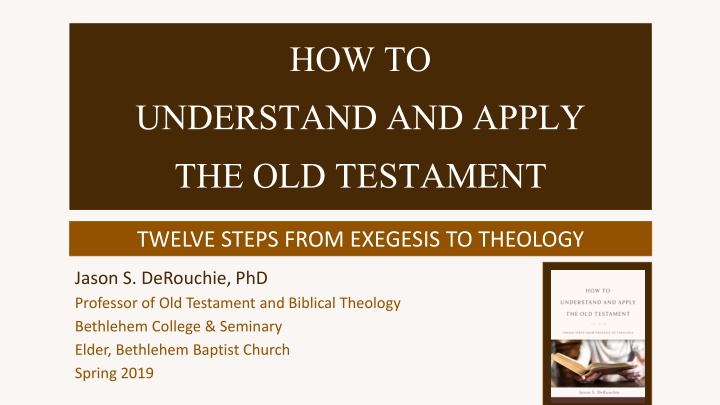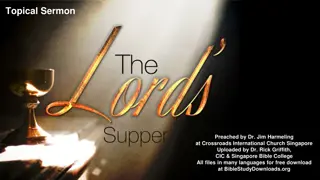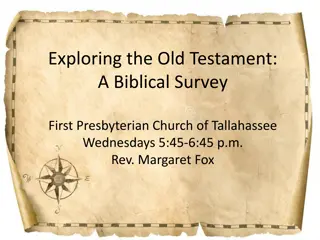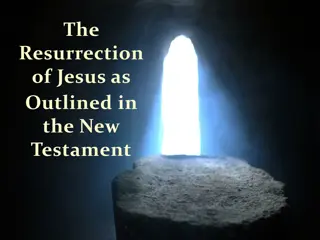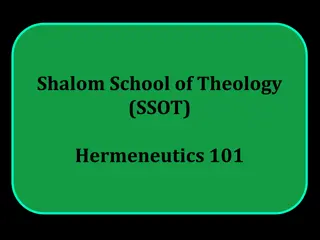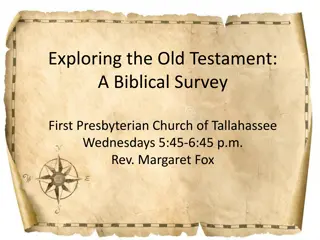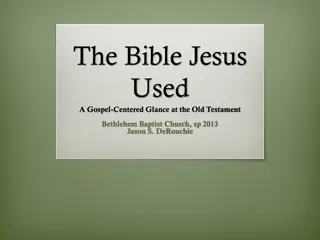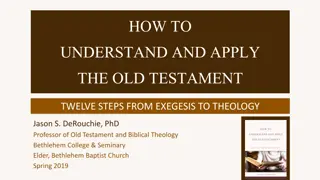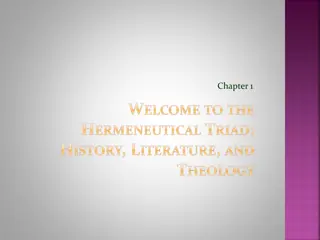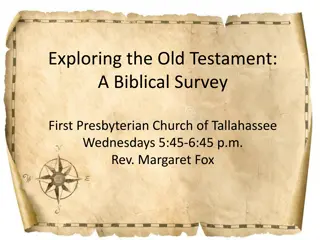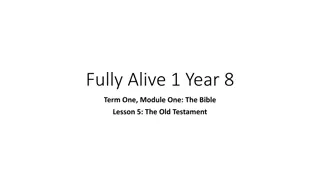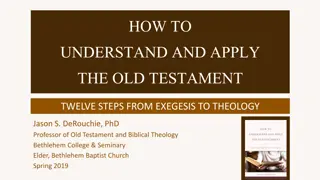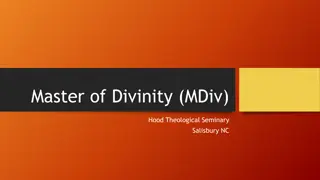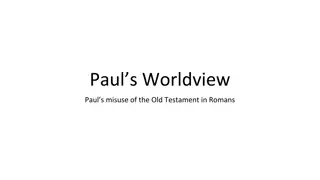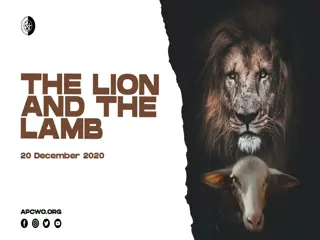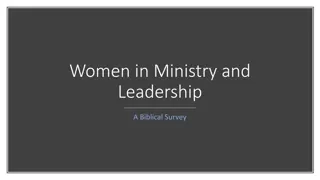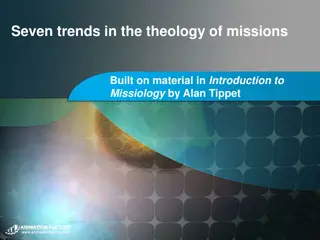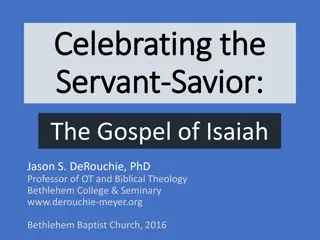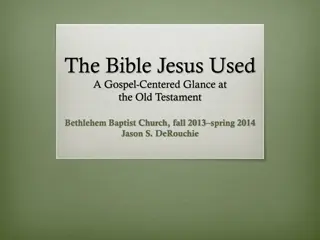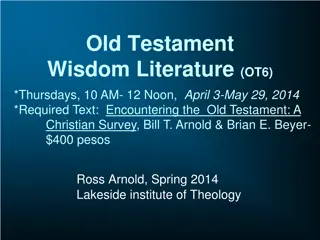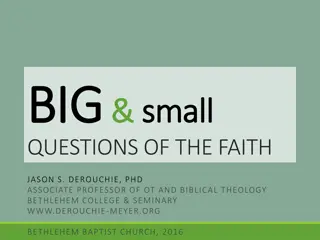Applying the Old Testament: A Guide to Biblical Theology
Explore the journey of moving from exegesis to theology in the Old Testament using twelve essential steps. Discover how to uncover meaning, connect to Biblical theology, and apply lessons to your life. Delve into the presuppositions and approaches of Biblical theology for a deeper understanding of the text.
Download Presentation

Please find below an Image/Link to download the presentation.
The content on the website is provided AS IS for your information and personal use only. It may not be sold, licensed, or shared on other websites without obtaining consent from the author.If you encounter any issues during the download, it is possible that the publisher has removed the file from their server.
You are allowed to download the files provided on this website for personal or commercial use, subject to the condition that they are used lawfully. All files are the property of their respective owners.
The content on the website is provided AS IS for your information and personal use only. It may not be sold, licensed, or shared on other websites without obtaining consent from the author.
E N D
Presentation Transcript
HOW TO UNDERSTAND AND APPLY THE OLD TESTAMENT TWELVE STEPS FROM EXEGESIS TO THEOLOGY Jason S. DeRouchie, PhD Professor of Old Testament and Biblical Theology Bethlehem College & Seminary Elder, Bethlehem Baptist Church Spring 2019
STEPS IN THE JOURNEY Part 1: Text Part 2: Observation Part 3: Context Part 4: Meaning What does the passage mean? 10. Biblical Theology 11. Systematic Theology Part 5: Application
10. BIBLICAL THEOLOGY Goal: Consider how your passage connects to the Bible s overall story line or message and points to Christ. The Presuppositions of Biblical Theology The Nature of Biblical Theology The Bible s Frame, Form, Focus, and Fulcrum
The Presuppositions of Biblical Theology Event vs. Text: Is the locus of special revelation a historical event in space and time or a written account? Biblical theology is a textual discipline that is informed by the historical context within which it developed.
Criticism vs. Canon: What is the nature and object of biblical-theological inquiry? Two common approaches: o Critical and deconstructive o Submissive and constructive The object of biblical theology: o Scope: The final form of the canon, God s revealed Word (2 Tim 3:16 17; 1 Pet 1:20 21), not a hypothetical reconstruction o Makeup: Unity from one divine author speaking through a diversity of human authors; canonical structure (Luke 11:51; 24:44)
Descriptive vs. Prescriptive: Do we approach the Bible like all other literature, or does the nature of Scripture as God s Word demand a special interpretive approach for a unique purpose? Scripture s similarity to other books. As God s Word spoken through human words in history, Scripture is in some ways like every human document (i.e., conditioned by the language, culture, and situations of the time) and therefore requires normal interpretive paths for inquiry. o 2 Tim 2:7. Think over what I say, for the Lord will give you understanding in everything.
Descriptive vs. Prescriptive: Do we approach the Bible like all other literature, or does the nature of Scripture as God s Word demand a special interpretive approach for a unique purpose? Scripture s similarity to other books. Scripture s uniqueness. As God s Word, Scripture is unlike all other books and therefore requires spiritual help for full appropriation. o We need God-given help. 1 Cor 2:14. The natural person does not accept the things of the Spirit of God, for they are folly to him, and he is not able to understand them because they are spiritually discerned. o We need the lens of Christ. 2 Cor 3:14. But their minds were hardened. For to this day, when they read the old covenant, the same veil remains unlifted, because only through Christ is it taken away.
Theologies vs. Theology: Is it enough to interpret the biblical books historically as distinct theologies (parts), or must we also consider them in light of one another as a unity (whole)? Because God is ultimate author of Scripture (2 Pet 1:21), biblical theology s task cannot end by shaping theologies of corpora (e.g., Law, Prophets) or human authors (e.g., Moses, Isaiah) but must push for a unified theology of the whole Bible.
The Nature of Biblical Theology Definition: Long Definition: A way of analyzing and synthesizing what the Bible reveals about God and his relations with the world that makes organic salvation-historical and literary-canonical connections with the whole of Scripture on its own terms, especially with respect to how the Old and New Testaments progress, integrate, and climax in Christ. Short Definition: Analyzing and synthesizing how the whole Bible progresses, integrates, and climaxes in Christ.
The Task, Part 1: Biblical theology analyzes and synthesizes what the Bible reveals about God and his relations with the world. Biblical theology interprets the final form of the Christian Bible Old and New Testaments. As Testaments, Scripture is grounded in history and bears a covenantal and thus canonical makeup. That God s revelation comes through Old and New Testaments highlights both Scripture s unity and diversity, with foundation giving rise to fulfillment.
The Task, Part 2: Biblical theology makes organic connections within the whole of Scripture. Biblical theology is about natural, unforced connections within Scripture in a way that recognizes growth or progress in a thought or concepts and lets the Bible speak in accordance with its own contours, structures, language, and flow. All the Bible grows out of God s unchanging nature and must be understood to align with his unified purpose of exalting himself over all things, ultimately through Jesus (Eph 1:10; Col 1:20). This unity is what makes biblical theology necessary and possible.
Salvation-Historical Connections: Biblical theology makes organic salvation-historical connections within the whole of Scripture on its own terms. Introduction: o Salvation history is the progressive narrative unfolding of God s kingdom plan through the various covenants, events, people, and institutions, all climaxing in the person and work of Jesus. o Salvation history moves from creation to fall to redemption to consummation.
Gods Kingdom Plan OT Narrative Foundation K I N G D NT Narrative Fulfillment O M
Gods Kingdom Plan OT Narrative Foundation K Kickoff and rebellion Creation, fall, and flood I N G D NT Narrative Fulfillment O M
Gods Kingdom Plan OT Narrative Foundation K Kickoff and rebellion Creation, fall, and flood I Instrument of blessing Patriarchs N G D NT Narrative Fulfillment O M
Gods Kingdom Plan OT Narrative Foundation K Kickoff and rebellion Creation, fall, and flood I Instrument of blessing Patriarchs N Nation redeemed and commissioned G Exodus, Sinai, and wilderness D NT Narrative Fulfillment O M
Gods Kingdom Plan OT Narrative Foundation K Kickoff and rebellion Creation, fall, and flood I Instrument of blessing Patriarchs N Nation redeemed and commissioned G Government in the land Conquest and kingdoms Exodus, Sinai, and wilderness D NT Narrative Fulfillment O M
Gods Kingdom Plan OT Narrative Foundation K Kickoff and rebellion Creation, fall, and flood I Instrument of blessing Patriarchs N Nation redeemed and commissioned G Government in the land Conquest and kingdoms Exodus, Sinai, and wilderness D Dispersion and return Exile and initial restoration NT Narrative Fulfillment O M
Gods Kingdom Plan OT Narrative Foundation K Kickoff and rebellion Creation, fall, and flood I Instrument of blessing Patriarchs N Nation redeemed and commissioned G Government in the land Conquest and kingdoms Exodus, Sinai, and wilderness D Dispersion and return Exile and initial restoration NT Narrative Fulfillment O Overlap of the ages Christ s work and the church age M
Gods Kingdom Plan OT Narrative Foundation K Kickoff and rebellion Creation, fall, and flood I Instrument of blessing Patriarchs N Nation redeemed and commissioned G Government in the land Conquest and kingdoms Exodus, Sinai, and wilderness D Dispersion and return Exile and initial restoration NT Narrative Fulfillment O Overlap of the ages Christ s work and the church age M Mission accomplished Christ s return and kingdom consummation
Gods Kingdom Plan OT Narrative Foundation K Kickoff and rebellion Creation, fall, and flood I Instrument of blessing Patriarchs N Nation redeemed and commissioned G Government in the land Conquest and kingdoms Exodus, Sinai, and wilderness D Dispersion and return Exile and initial restoration NT Narrative Fulfillment O Overlap of the ages Christ s work and the church age M Mission accomplished Christ s return and kingdom consummation
Different ways to make salvation-historical connections: o Thematic development (e.g., creation, covenant, temple, law, atonement, mission, exodus, etc.)
Different ways to make salvation-historical connections: o Thematic development o Covenantal continuity and discontinuity (Adamic-Noahic Abrahamic Mosaic Davidic New)
Different ways to make salvation-historical connections: o Thematic development o Covenantal continuity and discontinuity o Type vs. Antitype Typology: The study of analogical correspodnences among revealed truths about persons, events, institutions, and other things within the historical framework of God s special revelation, which, from a retrospective view, are of a prophetic nature an dare escalated in their meaning (Beale, Handbook on the New Testament Use of the Old Testament, 14).
Different ways to make salvation-historical connections: o Thematic development o Covenantal continuity and discontinuity o Type vs. Antitype o Promise and Fulfillment 2 Cor 1:20. All the promises of God find their Yes in [Christ].
Different ways to make salvation-historical connections: o Thematic development o Covenantal continuity and discontinuity o Type vs. Antitype o Promise and Fulfillment o Use of the Old Testament in the Old and New Testaments
Literary-Canonical Connections: Biblical theology makes organic literary-canonical connections with the whole of Scripture on its own terms. The Bible s composition and structure Covenant Established Enforced Law Former Prophets Prophets Gospels Acts General Epistles Covenant Covenant Enjoyed Latter Former Writings Pauline Epistles & Hebrews Commentary Latter Writings Revelation OT NT Narrative Narrative Commentary Narrative
Literary-Canonical Connections: Biblical theology makes organic literary-canonical connections with the whole of Scripture on its own terms. The Bible s composition and structure The Bible s historical details
The Relationship of the Testaments: Biblical theology wrestles with how the Old and New Testaments progress and integrate. Building off the OT story of salvation history, G. K. Beale (Handbook, 96 102) notes that the NT authors: o Assume corporate solidarity, in which the one can represent the many. o View the Messiah as representing the true (remnant) Israel of the old covenant and the true (consummate) Israel, the church, of the new covenant.
o Believe history is unified by a wise and sovereign plan so that God designs the earlier parts to clarify and correspond and point to the latter parts. o Are convinced that the age of eschatological fulfillment has come in Christ. o Believe that Christ as the center of history is the key to interpreting the earlier portions of the Old and New Testaments. The NT provides both the answer key and algorithm for interpreting the OT.
The Centrality of Christ: Biblical theology wrestles with how the Old and New Testaments climax in Christ. In various ways, all Scripture is about Christ and anticipates him and the mission he would spark. o John 5:39. You search the Scriptures because you think that in them you have eternal life; and it is they that bear witness about me. o John 8:56. Your father Abraham rejoiced that he would see my day. He saw it and was glad. o Matt 13:17. For truly, I say to you, many prophets and righteous people longed to see what you see, and did not see it, and to hear what you hear, and did not hear it.
o 1 Cor 2:2. For I decided to know nothing among you except Jesus Christ and him crucified. o Luke 24:45 47. Then [Jesus] opened their minds to understand the Scriptures, 46and said to them, Thus it is written, that the Christ should suffer and on the third day rise from the dead, 47 and that repentance for the forgiveness of sins should be proclaimed in his name to all nations, beginning from Jerusalem. o Acts 26:22 23. To this day I have had the help that comes from God, and so I stand here testifying both to small and great, saying nothing but what the prophets and Moses said would come to pass: 23 that the Christ must suffer and that, by being the first to rise from the dead, he would proclaim light both to our people and to the Gentiles.
Christ brings climax to redemptive history and fulfills both law and prophecy. o Luke 16:16. The Law and the Prophets were until John; since then the good news of the kingdom of God is preached. o Gal 3:24 25. The law was our guardian until Christ came, in order that we might be justified by faith. 25 But now that faith has come, we are no longer under a guardian. o Matt 5:17 18. Do not think that I have come to abolish the Law or the Prophets; I have not come to abolish them but to fulfill them. 18 For truly, I say to you, until heaven and earth pass away, not an iota, not a dot, will pass from the Law until all is accomplished. o Acts 3:18. But what God foretold by the mouth of all the prophets, that his Christ would suffer, he thus fulfilled.
o Rom 1:13. Paul, a servant of Christ Jesus, called to be an apostle, set apart for the gospel of God, 2 which he promised beforehand through his prophets in the holy Scriptures, 3 concerning his Son.
Christ is the necessary lens by which we interpret and apply the Old Testament. o Rom 10:4. For Christ is the end of the law for righteousness to everyone who believes. o Rom 16:25. Now to him who is able to strengthen you according to my gospel and the preaching of Jesus Christ, according to the revelation of the mystery that was kept secret for long ages 26 but has now been disclosed and through the prophetic writings has been made known to all nations, according to the command of the eternal God, to bring about the obedience of faith . o 2 Cor 1:20. For all the promises of God find their Yes in him. That is why it is through him that we utter our Amen to God for his glory. o 2 Cor 3:14. But their minds were hardened. For to this day, when they read the old covenant, that same veil remains unlifted, because only through Christ is it taken away.
The Bibles Frame, Form, Focus, and Fulcrum Frame (Content: What?): God reigns, saves, and satisfies Form (Means: How?): through covenant Focus(Purpose: Why?): for God s glory Fulcrum (Sphere: Whom?): in Christ God reigns, saves, and satisfies through covenant for his glory in Christ.
